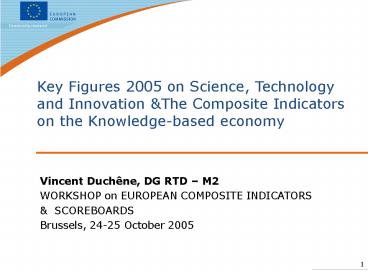Key Figures 2005 on Science, Technology and Innovation PowerPoint PPT Presentation
1 / 16
Title: Key Figures 2005 on Science, Technology and Innovation
1
Key Figures 2005 on Science, Technology and
Innovation The Composite Indicators on the
Knowledge-based economy
Vincent Duchêne, DG RTD M2 WORKSHOP on EUROPEAN
COMPOSITE INDICATORS SCOREBOARDS Brussels,
24-25 October 2005
2
Key Figures on STI
- Published yearly since 1998
- Main indicators (OECD, Eurostat) to take stock of
position of EU (and Member States) in Science,
Technology the Knowledge-Based Economy,
vis-à-vis main competitors (based on set of /-
35 indicators) - Usually consists of 3 parts
- Performance of the EU in the global
macro-economic context - Economic growth, Employment, Productivity
- 2 Composite indicators on the KBE (Investment in
the KBE, Performance in the transition towards
the KBE) - Input-side - Investment in the KBE
- RD Expenditure, Execution of RD, patterns of
financing RD (links private RD public RD - RD spending by level of technology, by size
class - Complementary sources for financing of domestic
RD International flows of RD spending,
High-tech Venture capital, tax incentives to RD - Education expenditure on (higher) education,
Human Resources in ST (researchers, PhDs,
international migration)
3
Key Figures on STI
- 3. Output-side - Performance of the KBE
- ? Scientific output scientific publications,
citations, co-publications - ? Technological output patenting activity,
co-patenting, ICT- Biotech-patents - ? Competitiveness of High-tech industries
high-tech trade, sector-specific productivity
performance - Innovation of 2005 edition
- Data up to 2003 ? First time official data one
year after Barcelona Council (March 2002) 3 -
2/3 targets - Integration China
4
CIs on the KBE Why ?
- Since 2002 edition of KF, integration of 2
Composite Indicators on the knowledge-based
economy - CI of Investment in the KBE
- CI of Performance in the transition towards the
KBE - Requested in July 2001 by Commissioner for
Research Ph. Busquin - Context Lisbon strategy structural indicators
- Aim
- Single measure (indicator) to capture progress
towards KBE (knowledge dimension of Lisbon
strategy) - Attract media attention promote support for KBE
related policies - Reinforce / broaden monitoring of section
Innovation Research in Structural Indicators
database
5
CIs on the KBE Process
- Pre-conditions
- Transparent and easy-to-understand
- Clear political message
- Broad base (KBE more than technology)
- Robust Methodology
- Iterative, collective process
- Co-operation with EC Services (Estat, EAC, Infso,
Entr, JRC-Ispra, Ecfin), national stat offices
(through ESS), OECD - External assessment by MERIT() on
appropriatedness of - Methodologies
- Constituent indicators
- () ARUNDEL, A. and BORDOY, C., Methodological
Evaluation of DG Researchs Composite Indicators
for the Knowledge-based Economy, MERIT, June 2002)
6
CIs on the KBE 4 steps
- Selection appropriate indicators
- Normalisation / standardisation measurement
units - Weighting scheme
- Robustness tests (checking steps 1 to 3
imputation missing data cfr. Presentation
Stefano Tarantola) - Two Composite Indicators on the KBE
- Investment in the KBE (capacity to create /
absorb new knowledge) - Performance in the transition towards a KBE
(capacity to transform new knowledge tech.
econ. progress)
7
1. Selection Component indicators
- 2 dimensions in Investment in the KBE
creation and diffusion of knowledge - 4 criteria for selection
- Policy relevance
- Reliability
- Coverage (over time EU-15)
- Redundancy (Principal Component Analysis)
8
2. Standardisation Method
- 2 selection Criteria
- simple and easy-to-understand
- low sensitivity to outliers
- Selection
- M1 ok, but no interval-data
- M2 more sensitive to outliers
- M3gtM4 M4 less sensitive but M3 simpler
Notes is the value of indicator j for country i
at time t. is the weight given to indicator j in
the composite index. In equation 1, p an
arbitrarily chosen threshold above and below the
mean. Source Arundel and Bordoy, p. 7
9
2. Standardisation Methods 3 4 very similar
results
R²0.998
Source ARUNDEL and BORDOY, 2002, p. 11
10
3. Weightings
- Problem there is no magic formula giving the
contribution of RD, Education etc to KBE ! - Option 1 Using Factor Analysis (Principal
Component Analysis) to determine weights and to
aggregate component indicators ! - Advantages 1) no redundancy anymore, 2)
weightsloadings of Principal Components - Disadvantages 1) complexity ! (whats in PC1) ?,
2) not comparable over time (weights will change
from year to year since data/indicators change) - Option 2 Equal weights to each conceptual group
of indicators (creation vs. diffusion) equal
weights to each indicator within each conceptual
group - Option 2 selected !
11
Component indicators weightings CI on
investment in the KBE
12/24
12/24
12
Component indicators weightings CI on
performance in the transition towards the KBE
13
Composite indicator on Investment in the KBE
1997-2002
14
Country-specific deviations scores where is the
difference ?
15
Investment vs Performance in the KBE Is more
better ?
16
Towards the Second Generation ...
- Integration new / better component indicators
(ICT, technology diffusion etc) - Methodological improvements (BoD-method ?
Imputation missing values ?) - New Composite Indicators on Framework conditions
(state aid, public procurement, fiscal incentives
and other indirect measures, etc) ?

